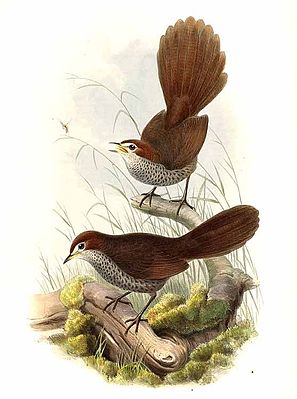Red-headed bristle bird
| Red-headed bristle bird | ||||||||||||
|---|---|---|---|---|---|---|---|---|---|---|---|---|

Red-headed bristle bird ( Dasyornis broadbenti ) |
||||||||||||
| Systematics | ||||||||||||
|
||||||||||||
| Scientific name | ||||||||||||
| Dasyornis broadbenti | ||||||||||||
| ( McCoy , 1867) |
The red-headed bristle bird ( Dasyornis broadbenti ), also known as the red-headed lacquer bird or the cinnamon-head bristle sniper , is a rare bird in the bristle bird family .
description
It takes its name from its brown, shiny, lacquered, water-repellent plumage on its back, head and tail. The belly side is colored white, in the chest area it is slightly gray. The beak is black, the feet are gray. It has fine feather bristles at the base of its beak, which are probably used to protect the eyes.
Distribution and way of life
Although the birds can fly well, they mostly live tucked away on the ground in the heather and grassy areas in southeastern and southwestern Australia . The bird feeds mainly on seeds, insects and other invertebrates that it finds on the ground. The males usually sing in small groups of up to five animals to impress passing females. The birds singing resembles a harsh squeak.
There are four subspecies:
- Dasyornis broadbenti littoralis Distribution: Southwest Australia, last seen in 1940, probably extinct
- Dasyornis broadbenti whitei Distribution: South Australia
- Dasyornis broadbenti broadbenti Distribution: South Australia, Victoria
- Dasyornis broadbenti caryochrous Distribution: South Victoria
Reproduction
The breeding takes place from September to December. The female builds an oval nest of grass on the ground, which is lined with moss on the inside. The eggs, usually two, have white, red and purple spots. The breeding period is 11 to 22 days, the nestling time of the young up to 25 days. After that, the young birds are looked after by both parents for up to eight weeks.
Danger
Like all ground-nesting birds in Australia, these birds are endangered by introduced rats, foxes, cats and rabbits, which destroy the brood and change their habitat due to agriculture, urban expansion and the occurrence of bushfires. The IUCN classifies this species as not endangered due to its wide distribution area ( Least Concern ).
literature
- Christopher M. Perrins : The Great Encyclopedia of Birds. From the English, Orbis-Verlag, Munich 1996, ISBN 3-572-00810-7 , pp. 295, 297.
- Goetz Rheinwald (ed.), Cyril Walker: Atlas of the bird world. Unipart, Remseck near Stuttgart 1994, ISBN 978-3-8122-3399-6 , p. 186.
- Christopher M. Perrins (Ed.): The FSVO encyclopedia birds of the world. Translated from the English by Einhard Bezzel. BLV, Munich / Vienna / Zurich 2004, ISBN 978-3-405-16682-3 , pp. 470-471 (title of the original English edition: The New Encyclopedia Of Birds. Oxford University Press, Oxford 2003).
Web links
- Dasyornis broadbenti inthe IUCN 2012 Red List of Threatened Species . Listed by: BirdLife International, 2012. Retrieved May 18, 2013.
